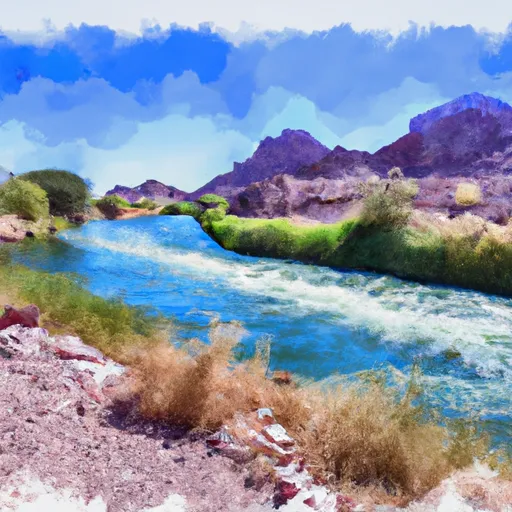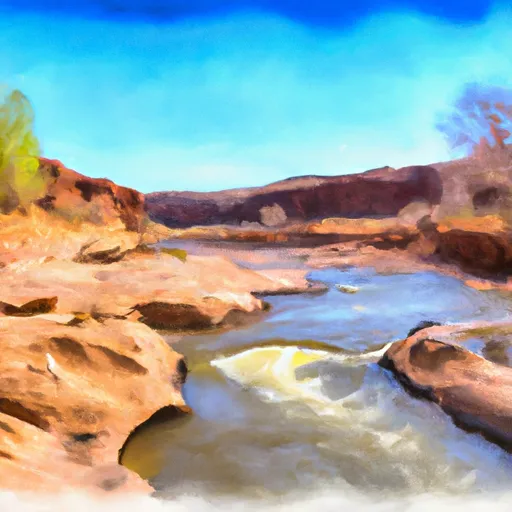2026-01-04T17:00:00-07:00
The National Weather Service in Denver has issued a Fire Weather Watch for wind and low relative humidity, which is in effect from Sunday morning through Sunday afternoon. * AFFECTED AREA...Fire Weather Zones 214, 216, 239, 240 and 241. * TIMING...From late Sunday morning through Sunday afternoon. * WINDS...West 10 to 20 mph with gusts 30 to 45 mph. * RELATIVE HUMIDITY...12 to 18%. * IMPACTS...Conditions will be favorable for rapid fire spread. Avoid outdoor burning and any activity that may produce a spark and start a wildfire.
Summary
Total streamflow across the
Colorado River
was last observed at
45,209
cfs, and is expected to yield approximately
89,671
acre-ft of water today; about 72%
of normal.
Average streamflow for this time of year is
62,988 cfs,
with recent peaks last observed
on
2017-08-29 when daily discharge volume was observed at
497,084 cfs.
Maximum discharge along the river is currently at the
Colorado River At Lees Ferry
reporting a streamflow rate of 9,730 cfs.
However, the streamgauge with the highest stage along the river is the
Colorado River Below Parker Dam
with a gauge stage of 65.46 ft.
This river is monitored from 36 different streamgauging stations along the Colorado River, the highest being situated at an altitude of 8,756 ft, the
Colorado R Below Baker Gulch.
River Details
| Last Updated | 2026-01-02 |
| Discharge Volume | 89,671 ACRE-FT |
| Streamflow |
45,209.0 cfs
+4725.1 cfs (+11.67%) |
| Percent of Normal | 71.77% |
| Maximum |
497,084.0 cfs
2017-08-29 |
| Seasonal Avg | 62,988 cfs |
River Streamflow Levels
| Streamgauge | Streamflow | Gauge Stage | 24hr Change (%) | % Normal | Minimum (cfs) | Maximum (cfs) | Air Temp | Elevation |
|---|---|---|---|---|---|---|---|---|
|
Colorado R Below Baker Gulch
USGS 09010500 |
20 cfs | 4.31 ft | 7.73 | |||||
|
Colorado River Bl Shadow Mountain Reservoir
USGS 09015000 |
21 cfs | 1.44 ft | 11.29 | |||||
|
Colorado River Below Lake Granby
USGS 09019000 |
21 cfs | 3.25 ft | 0 | |||||
|
Colorado River Near Granby
USGS 09019500 |
73 cfs | 1.61 ft | 7.36 | |||||
|
Colorado River At Windy Gap
USGS 09034250 |
95 cfs | 3.94 ft | 65.38 | |||||
|
Colorado River Near Kremmling
USGS 09058000 |
420 cfs | 3.89 ft | -1.41 | |||||
|
Colorado River Near Dotsero
USGS 09070500 |
688 cfs | 1.97 ft | 8.86 | |||||
|
Colorado River Below Glenwood Springs
USGS 09085100 |
1100 cfs | 3.55 ft | 6.8 | |||||
|
Colorado River Near Cameo
USGS 09095500 |
1130 cfs | 3.26 ft | 26.97 | |||||
|
Colorado River Near Colorado-Utah State Line
USGS 09163500 |
1830 cfs | 2.69 ft | -3.68 | |||||
|
Colorado River Near Cisco
USGS 09180500 |
1920 cfs | 1.98 ft | -7.69 | |||||
|
Colorado River At Potash
USGS 09185600 |
2160 cfs | 5.63 ft | -9.24 | |||||
|
Colorado River At Lees Ferry
USGS 09380000 |
9730 cfs | 8.56 ft | 28.53 | |||||
|
Colorado River Near Grand Canyon
USGS 09402500 |
9370 cfs | 7.17 ft | 28.36 | |||||
|
Colorado Rv Nr Gail
USGS 08117995 |
0 cfs | 0.15 ft | None | |||||
|
Colorado Rv Nr Ira
USGS 08119500 |
817 cfs | 3.89 ft | ||||||
|
Colorado Rv At Colorado City
USGS 08121000 |
0 cfs | 3.37 ft | 0 | |||||
|
Colorado Rv Abv Silver
USGS 08123850 |
0 cfs | 1.81 ft | 0 | |||||
|
Colorado Rv At Robert Lee
USGS 08124000 |
0 cfs | 0.97 ft | None | |||||
|
Colorado Rv Nr Ballinger
USGS 08126380 |
0 cfs | 4.06 ft | 12.12 | |||||
|
Colorado Rv Nr Stacy
USGS 08136700 |
5 cfs | 4.52 ft | -15.91 | |||||
|
Colorado River Above Diamond Creek Nr Peach Spring
USGS 09404200 |
8820 cfs | 47.54 ft | -3.18 | |||||
|
Colorado Rv Nr San Saba
USGS 08147000 |
108 cfs | 2.29 ft | 0 | |||||
|
Colorado River Below Davis Dam
USGS 09423000 |
5050 cfs | 7.46 ft | -3.81 | |||||
|
Colorado Rv At Austin
USGS 08158000 |
285 cfs | 13.47 ft | 1.79 | |||||
|
Colorado River Below Parker Dam
USGS 09427520 |
2300 cfs | 65.46 ft | -30.09 | |||||
|
Colorado Rv At Bastrop
USGS 08159200 |
608 cfs | 3.1 ft | 3.58 | |||||
|
Colorado Rv At Smithville
USGS 08159500 |
878 cfs | 2.15 ft | -3.94 | |||||
|
Colorado River Below Palo Verde Dam
USGS 09429100 |
1140 cfs | 0.26 ft | -2.56 | |||||
|
Colorado Rv Abv La Grange
USGS 08160400 |
822 cfs | 4.52 ft | 0 | |||||
|
Colorado Rv At Columbus
USGS 08161000 |
460 cfs | 9.93 ft | 3.37 | |||||
|
Colorado River Below Laguna Dam
USGS 09429600 |
923 cfs | 5.34 ft | 82.41 | |||||
|
Colorado R Blw Yuma Main Canal Ww At Yuma
USGS 09521100 |
1550 cfs | 10.81 ft | 115.28 | |||||
|
Colorado Rv At Wharton
USGS 08162000 |
388 cfs | 7.72 ft | 19.75 | |||||
|
Colorado Rv Nr Bay City
USGS 08162500 |
2670 cfs | 2.63 ft | -33.91 | |||||
|
Colorado Rv Nr Wadsworth
USGS 08162501 |
837 cfs | 1.43 ft | -33.04 |
Seasonal Discharge Comparison
Maximum Streamflow Discharge
Streamflow Elevation Profile
The Colorado River is one of the principal rivers (along with the Rio Grande) in the Southwestern United States and northern Mexico. The 1,450-mile-long (2,330 km) river drains an expansive, arid watershed that encompasses parts of seven U.S. and two Mexican states. Starting in the central Rocky Mountains of Colorado, the river flows generally southwest across the Colorado Plateau and through the Grand Canyon before reaching Lake Mead on the Arizona–Nevada border, where it turns south toward the international border. After entering Mexico, the Colorado approaches the mostly dry Colorado River Delta at the tip of the Gulf of California between Baja California and Sonora.
Known for its dramatic canyons, whitewater rapids, and eleven U.S. National Parks, the Colorado River and its tributaries are a vital source of water for 40 million people. The river and its tributaries are controlled by an extensive system of dams, reservoirs, and aqueducts, which in most years divert its entire flow for agricultural irrigation and domestic water supply. Its large flow and steep gradient are used for generating hydroelectric power, and its major dams regulate peaking power demands in much of the Intermountain West. Intensive water consumption has dried up the lower 100 miles (160 km) of the river, which has rarely reached the sea since the 1960s.Beginning with small bands of nomadic hunter-gatherers, Native Americans have inhabited the Colorado River basin for at least 8,000 years. Between 2,000 and 1,000 years ago, the watershed was home to large agricultural civilizations—considered some of the most sophisticated indigenous North American cultures—which eventually declined due to a combination of severe drought and poor land use practices. Most native peoples that inhabit the region today are descended from other groups that settled there beginning about 1,000 years ago. Europeans first entered the Colorado Basin in the 16th century, when explorers from Spain began mapping and claiming the area, which became part of Mexico upon its independence in 1821. Early contact between Europeans and Native Americans was generally limited to the fur trade in the headwaters and sporadic trade interactions along the lower river.
After most of the Colorado River basin became part of the U.S. in 1846, much of the river's course was still the subject of myths and speculation. Several expeditions charted the Colorado in the mid-19th century—one of which, led by John Wesley Powell, was the first to run the rapids of the Grand Canyon. American explorers collected valuable information that was later used to develop the river for navigation and water supply. Large-scale settlement of the lower basin began in the mid- to late-19th century, with steamboats providing transportation from the Gulf of California to landings along the river that linked to wagon roads to the interior. Starting in the 1860s, gold and silver strikes drew prospectors to parts of the upper Colorado River basin.
Large engineering works began around the start of the 20th century, with major guidelines established in a series of international and U.S. interstate treaties known as the "Law of the River". The U.S. federal government was the main driving force behind the construction of dams and aqueducts, although many state and local water agencies were also involved. Most of the major dams were built between 1910 and 1970; the system keystone, Hoover Dam, was completed in 1935. The Colorado is now considered among the most controlled and litigated rivers in the world, with every drop of its water fully allocated.
The environmental movement in the American Southwest has opposed the damming and diversion of the Colorado River system because of detrimental effects on the ecology and natural beauty of the river and its tributaries. During the construction of Glen Canyon Dam, environmental organizations vowed to block any further development of the river, and a number of later dam and aqueduct proposals were defeated by citizen opposition. As demands for Colorado River water continue to rise, the level of human development and control of the river continues to generate controversy.

 Grand Canyon
Grand Canyon
 Park Boundary To Confluence With The Colorado River
Park Boundary To Confluence With The Colorado River
 Paria River
Paria River